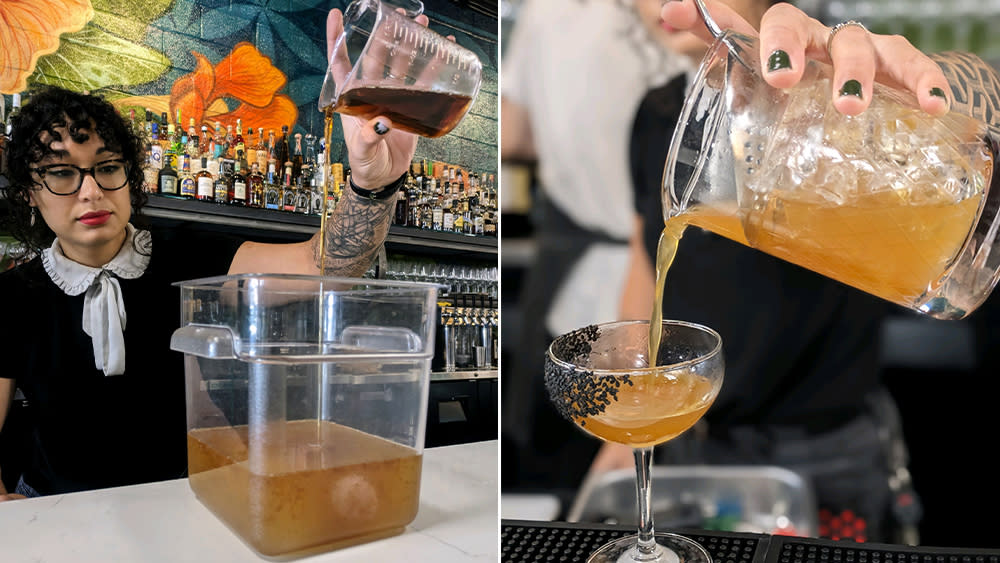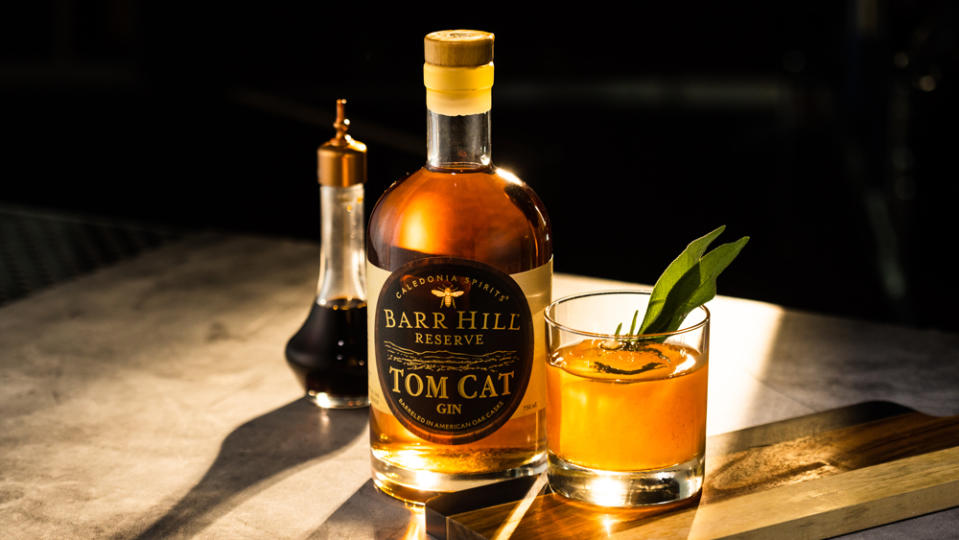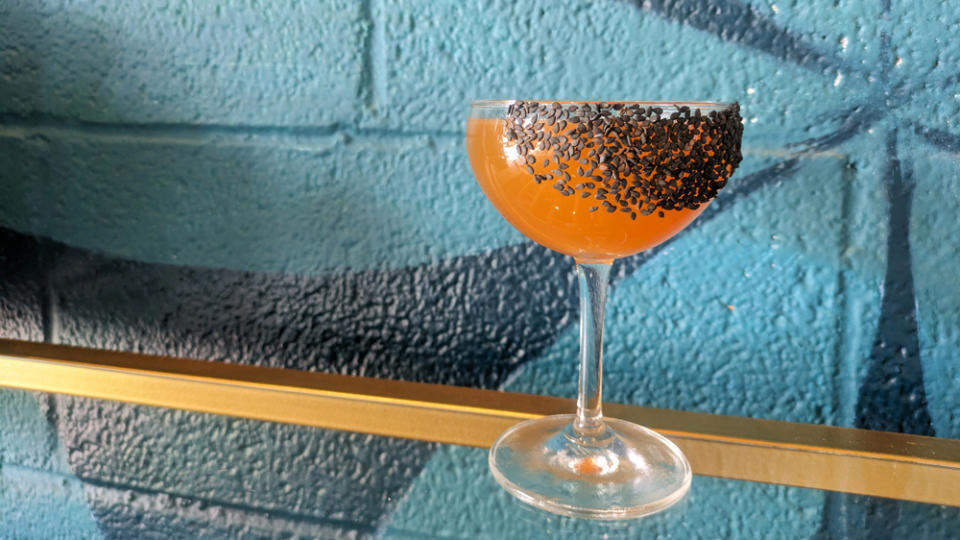Forget Lime. Bartenders Are Now Adding Pepperoni and Duck Flavor to Cocktails.

Inside Dallas’s smart, intimate cocktail den Apothecary there are Hawthorne strainers and jiggers and shakers and most of the tools you’d expect at a craft bar. But you’ll also find centrifuges, liquid nitrogen, and iSi cannisters that befit Apothecary’s modernist approach. So it’s no surprise that the Old Fashioned on the current menu is certainly not old fashioned.
The cocktail, dubbed the Pekin Tom, is made with a bourbon washed in the fat from a duck confit, and it’s flavored additionally with stew-esque spices of bay leaf and thyme and a nod to Texas barbecue. “Because we finish the drink smoked, the first flavor note you get is pecan wood smoke, which prepares the palate to receive something rich, like duck confit,” says Tanner Agar, Apothecary’s owner and creative director. And it’s the hit of richness he believes makes the drink really stand out.
More from Robb Report
How to Make a Siesta, the Tequila Cocktail That's Refreshing and Complex
Vegas's Bellagio Hotel Just Opened a New Cocktail Bar With Top-Shelf Spirits and Caviar Bites
Martha Stewart Used a Small Iceberg to Chill Her Cocktail-and the Internet Isn't Happy About It
“Fat-washing a spirit is like spreading soft butter across warm bread,” Agar says. “It adds a velvety texture, and the process is easy, affordable, and transformative.” However, it’s not just bars with a modernist perspective pushing fat-washed spirits to new creative heights—from traditionalist strongholds to progressive cocktail dens, bars across the country are adding fresh twists to this tried-and-true technique.
Fat washing began in 2007 in Manhattan’s East Village, at a bar called PDT, when bartender Don Lee decided to pour cooled bacon fat into whiskey. After a few hours, he put the container in the freezer. Once the fat cap formed, he then strained the whiskey. It held a delicious, subtle, smoky, salty undertone, singing of bacon. That Benton’s Bacon Old Fashioned was a huge hit, and a modern cocktail technique went global.

So while fat washing might not be brand new, it has seen fresh energy this summer, and is ramping towards a spectacularly flavorful fall, as bartenders explore more esoteric fats—pepperoni to sesame oil to coconut—and reach for lighter spirits, like gin and vodka.
The Old Fashioned was the first template for fat washing, and it remains a favorite framework. What began with bacon has branched out. This summer, guests found vegetarian washed cocktails, and even Indian gravies behind the bar.
“Our Slow Cheetah is a coconut-fat washed Famous Grouse Scotch, with passion fruit liqueur, and Italicus Rosolio, which has notes of bergamot, Angostura and El Guapo Polynesian Kiss bitters,” says Carlo Caroscio, head bartender at The Danforth in Portland, Maine. This Old Fashioned variation’s surprising Tiki influences helped it sell in sweltering summer temps.
Further south, at Gulaabo—an Indian restaurant opened this summer in Manhattan’s Theater District—the kitchen focuses on Punjabi staples, like a beloved Chicken Makhani. Also known as Butter Chicken, the dish demands a decadent gravy, made with tomatoes, onions, garlic, ginger, red chili, garam masala, and fenugreek leaves, plus butter and cream. Mixologist Suyash Pande took extra sauce from the kitchen to the bar menu, by fat washing a whiskey with it. “We strain it using a coffee filter,” says Pande, “and use the whiskey, along with honey—an essential ingredient for Makhani—Peychaud’s and Angostura bitters. It’s finished with expressed grapefruit zest and garnished with house made naan.”

While some like Pande go bold with a complex Indian gravy, others are finding purchase in playing with lighter spirits, like gin and vodka. At the petite, 65-seat Da Toscano in New York’s West Village, General Manager Michelle DeSantis mixes St. George vodka with Corto Olive Oil, from California.
“We use about two liters of oil to fat wash the St. George,” she says, “and we rest the bottles in the wine cellar for two weeks before freezing and straining.”
The Olive Branch cocktail is a Martini riff, with Italian, Cocchi Americano vermouth, a saline solution and a Parmesan-stuffed olive garnish. “The process takes time, but it’s worth it,” DeSantis says. “It’s our No. 1 selling drink.”
At Market in Tampa’s Edition Hotel, beverage director Amy Racine is crafting another stirred classic with a twist, in her Pepper(groni)—a playful Negroni twist with pepperoni-washed gin.
“Pepperoni has such a diverse set of spices: fennel seed, black peppercorn, paprika, celery seed. All of those make the Negroni herbal and deeper in flavor,” Racine says. “That salty element also plays nicely off the sweetness of vermouth.” She’s experimented with yogurt too, adding a creamy tang to a punch recipe this summer. “Fat washed cocktails are becoming a part of that line up that we want to represent on our menu season-to-season,” she says.
Seasonality and clear spirits play into a fall, fat-washed cocktail cheekily called the Cuffing Season at the Gin Lane Bar. Inside the Barr Hill Distillery in Montpelier, Vermont, Barman Nate Canan-Zucker melts Vermont Creamery butter in a pan, until it takes on the hue of light toast. He then washes the company’s Tom Cat Gin, a juniper-forward spirit aged in American oak, with it. The Cuffing Season slides across the bartop in a Rocks glass, a single cube of ice and a combination of Cognac, a roasted butternut-squash syrup, cinnamon tincture and Angostura and apple bitters.

It might be a perfect, autumnal sip, but it has equal competition. “I wanted to take that idea of a carnival apple and combine it with the comforting elements of miso and toasted sesame oil,” says MJ Wheeler, bar director at Machete in Greensboro, North Carolina. The restaurant was a James Beard Best New Restaurant Semifinalist for 2023, and chef Kevin Cottrell’s food menu marries locally sourced Southern proteins—deviled farm eggs, duck and pork belly—with Asian pantry staples like umeboshi to shiso.
Wheeler went the same route for her forthcoming fall menu’s S-M-R-T cocktail, which begins with a base of vodka washed with nut oil. “When using lard,” Wheeler says, “you want about 14 to 16-percent fat-to-liquor ratio. Sesame oil is not as fatty as bacon. For this, we used a 32-percent ratio of sesame oil to vodka.”
She crafted a syrup from autumnal baking spices, miso and Granny Smith apples, and added a cardamom tincture. The result is a crisp-yet-creamy, nostalgia-in-a-glass styled drink that celebrates the harvest and the lure of a changing season.
The beauty and simplicity of this method has made it a perfect technique for every modern-day bartender, from the classist to the avant-garde. With the proliferation of fun combinations out there, one questions if we should even be using the word trend. Fat washing is, indeed, easy, affordable, and transformative, as Agar so aptly put it, and we cannot wait to see what’s next.
Best of Robb Report
Why a Heritage Turkey Is the Best Thanksgiving Bird—and How to Get One
The 10 Best Wines to Pair With Steak, From Cabernet to Malbec
Sign up for Robb Report's Newsletter. For the latest news, follow us on Facebook, Twitter, and Instagram.

